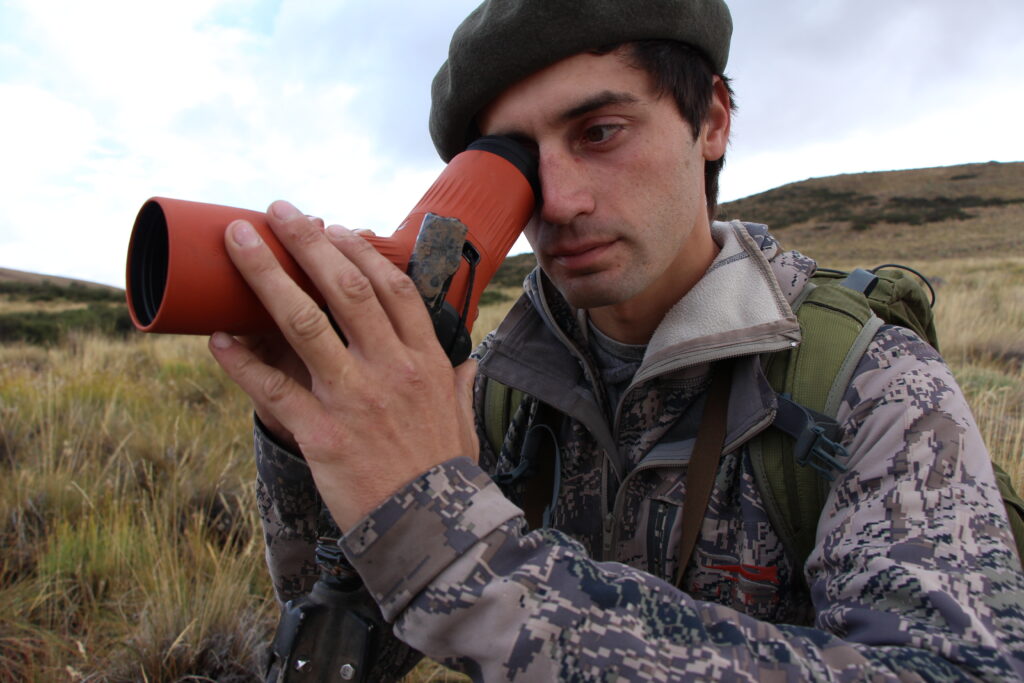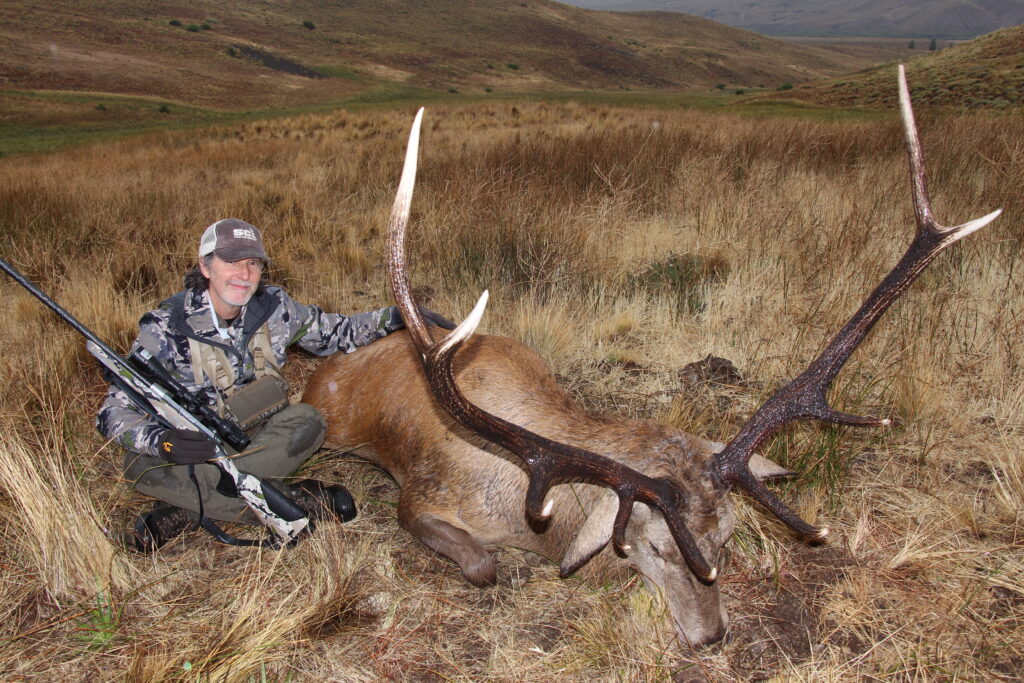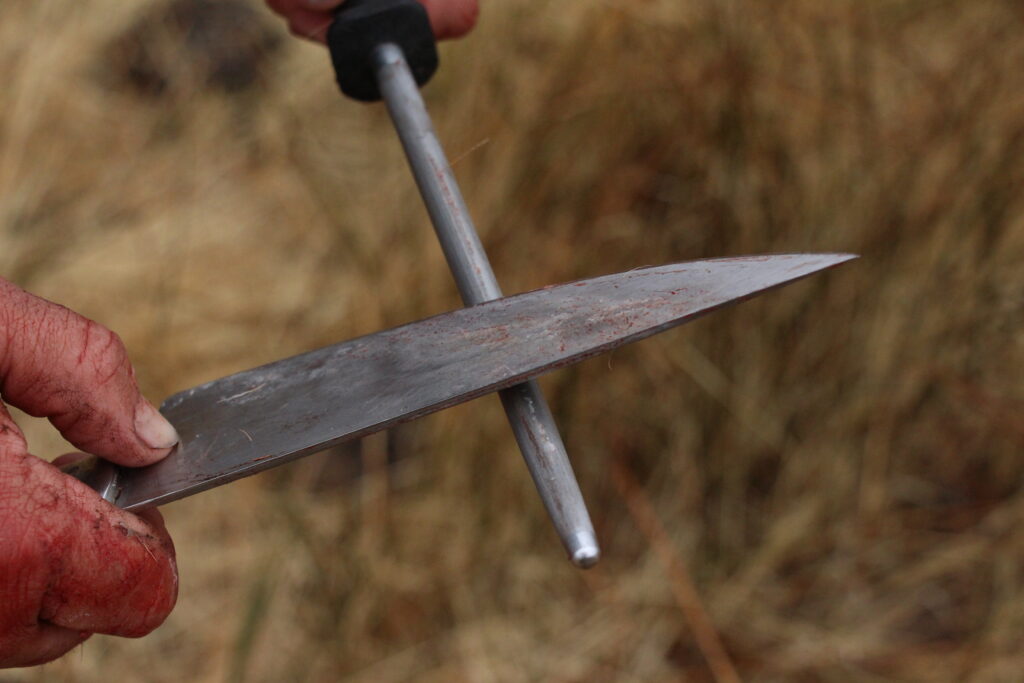In The Shadow of Tipiliuke
Patagonia’s Red Stag Roar Revs The Heart
Story and Photos By John Geiger, Safari Managing editor
Originally published in the May/June 2024 issue of Safari Magazine.
The eerie roars began before sunup. The angry, guttural warnings sounded like a combination of a lion and bugling elk. These stags warned others to stay away from their harem of hinds. If another male got too close, heads dropped and antlers clashed in a fight for ground and breeding rights. The haunting sounds also helped us hunters find the animals in the vast, undulating landscape in Argentina’s Patagonia.
Atop a hill, looking down into the sprawling valley of the Rio Chimehuìn, I heard dozens of roaring stags, each with an individual volume and cadence. Some were two miles away, others within several hundred yards. Some were hidden from sight but rattled the willows by the river. Others were out in the open, herding their hinds and watching out for intruders and perhaps hunters.

“This is incredible,” said Dean Capuano, who traveled from New England. “It never gets old.” He’s been back to Patagonia a dozen times to hunt these stag.
UPSIDE DOWN HEART
It’s exciting, addicting, different and despite the number of potential targets, it’s challenging to find the one you want and then get close enough to to make an effective, ethical shot.
These fascinating animals are red deer, Cervus elaphus, the third largest deer in the world after moose, elk and sambar deer. The males are called stags or harts, and the females are called hinds. They are larger than a mule deer and smaller than a Rocky Mountain elk.

While they seem right at home here in Argentina, they are not native here nor in New Zealand, where they are also a popular game animal. Europeans brought them from Hungary, Austria and Scotland just over 100 years ago.
The first red deer were introduced in 1906 by Pedro Luro, a wealthy rancher who created the first hunting estate in La Pampa Province. In 1924, deer were released in Patagonia, and after that, many other landowners imported deer releasing them all over the country.

Red deer now thrive here. Hunters travel from around the world to hear the roar and see the spectacle play out in the plains of La Pampa or the hills of Patagonia.
Outfitters offer free-range hunts in this region or La Pampa to the north and measure stags in the 300-inch SCI range. Puma are the second most common deer predator here. They will prey on fawns but rarely attack a full-grown deer. Humans are the first.
Capuano and I were on the hunt with local guide Adrian Mera of Tipiliuke Lodge in San Martin de los Andes.
Lodge owners Argentinian Kevin Tiemersma and American John Burrell opened this oasis 20 years ago and offer more than 60,000 acres to hunters pursuing free-range stag. The property is in the shadow of a tall granite peak the native Mapuche people call “Upside Down Heart,” or Tipiliuke. It’s an appropriate name because it sure looks like a top-down heart half buried, and it’s also the heart of the area, visible for miles in all directions.
Mera, Capuano and I crawled to the edge of a hill as the sun fought an overcast sky. Before we were at the top, we heard them. As we peaked over, we saw them. Scores of stags, perhaps hundreds of hinds in isolated herds spread across the valley.
These deer feed all night in the flat, verdant lowlands. Now, they were starting to slowly move up into the arid hills to bed toward us. The hinds are watchful but almost always have their heads down in the grasses and forbs. On the other hand, the stags rarely get a moment to graze or rest. This is their rut time of year, and they’re constantly looking, posturing, watching for other stags who might challenge them or get a crack at his hinds.
We glassed many stags through binoculars supplied by Capuano, who works for Swarovski Optik. We used 8×32, 8×42 EL Ranges, Z5 riflescopes with Ballistic Turret Flex, and a 56-power spotting scope. Good glass as important as gun and bullet in this kind of stag hunting in the hills of Patagonia.

“Oh, a nice one just came out of the timber, 12 o’clock, by the bend in the river,” Capuano said with binos to his eyes.
“Sì. Muy grande,” said Mera, who looked through the spotting scope. “Very much mass, and dark. Nice crown on the right side pero no crown on the left.”
Hunters look for crowns on both antlers. It’s what makes a stag rack look different from, say, an elk’s. Crowns are a minimum of three points at the very top of each main beam. The Scottish say it’s a crown if it could hold a whiskey glass. Once you see a stag with a crown, you can check for age, usually by noting the mass of the main beams, the number of points, the length of tines, number of tines, the width of the inside spread and other characteristics that make each rack unique. If it has two points at the top, it’s called an a horqueta or pitchfork. Hunters also put a premium on age. To keep the herds healthier in the future, hunters target the old, which gives the herd the new genetics of the younger stags. Often, the antlers of the oldest stags — those that are 10, 12 or 15 years old — are on the decline and are not as impressive as the younger compatriots. And hunters are OK with that because they know taking them out is best for the species. It’s proof that hunters are the most effective conservationists in the world.

Of course, the best of both worlds is an old stag with impressive headgear. And that’s what I was after.
Searching for that stag, my eyes and ears were on point. Each deep roar became the center of a grid as I glassed to find the source. Any draw, hillock, bushes or undulations in the land could hide a stag. We glassed miles and miles of bottomland for hours and saw hundreds of red deer. The wind direction precluded stalks on many stags. We decided to wait on our hill for a sure thing.
PRIME TIME
March and April, when summer turns to fall here in the Southern Hemisphere, is prime time for the roar and the stags care about nothing but fighting and breeding. These stags themselves would not be difficult to approach. The hinds, on the other hand, would move off should something on two legs approach and the stags would follow.
As light pushed out the gloom, the giant spire of Tipiliuke emerged from the clouds around it like a beacon.
I couldn’t help but glass up the side of Tipiliuke all the way to the top and noticed a cross on its very peak.
“Nine o’clock. Nice stag,” said Capuano as I snapped back and remembered why I was there.
It was 500 yards to the northeast of us. We decided to start a stalk, but another stag drew him away from us, 600, 650, now 700 yards. But to his right, we heard a new roar and another stag appeared. Although he was an horqueta, his rack was heavy and dark. Stags rub their antlers on the many pines and poplars in the area, giving them a rich color. This stag’s antlers were the color of chocolate, which contrasted with white tips like an old kudu. He had good mass through his main beams and 10 points. Best of all, he was old, much older than the first. I trained my Swaros on the big deer and fell for him. He roared as if daring me, and my heart beat faster. Could I hold it together for the shot?

We scooted to a large rock and then crawled across the backside of the ridge to get to within 200 yards.
Adrian sunk the shooting sticks into the earth for my sitting shot. The Browning X-Bolt 2 was sighted for 100 yards, and I held a little high to compensate for the 185-grain bullet. The Swaro scope had a custom turret called a BTF or ballistic turret flex, which was etched with the elevation for my bullet weight, barrel length and other factors in case I needed to dial for a longer shot.
The bull ramped up the intensity of the moment with his growling roar. No doubt he was talking to the other stags and his hinds, but it still made revved my heart and this moment singular. He milled about several hinds, and I had to wait for him to stand alone so no hind would be hit by a pass-through.
Finally, he stood alone, quartering to, as majestic as imaginable you could imagine. He looked over his herd like he was king of the world.
It occurred to me that if I made this shot, this bull would die within minutes, if not seconds. He would have bred his last hind. Taking him out of the gene pool now would mean a healthier future for the area’s deer population.
With confidence in my gear and knowledge of the important role of a hunter in wildlife conservation, I let him take one more roar and then added slight pressure to the trigger. He absorbed the hit and stumbled 20 yards.
The majestic antlers swayed, and he toppled over in front of Tipiliuke.
Capuano and Mera were integral to this success, and we clapped each other on the back and smiled wide.
I ran my hands along the main beams and was amazed at this great animal, now silent.
We quartered him there, cut out tenderloins, backstraps and neck meat. Two local gray foxes descended to finish off the carcass as we walked out. The younger bull now roared and gathered the scattered harem.

Back at the lodge, fellow hunter and master chef Sean Finley put the tenderloins over an outside fire. He added only salt, pepper and some rosemary. Tiemersma’s staff set the table beneath a roof of jasmine.
The work of the morning came full circle. We profoundly appreciated the good food, great company and fresh Malbec wine that the country is famous for.
Glasses up, we toasted to salude, dinero y amor.

SCI RECORD BOOK LEADERS
Of the SCI top 10 free-range red deer taken in South America, nine were killed in March and the other in April. If you’re planning on hunting Cervus elaphus, be there in late March or early April, when the season is turning from summer to fall and the roar is on.
These amazing Argentine red deer records were set in the Neuquén province of Patagonia and in the Pampas region.
Kenneth Erni took the highest-scoring South America red deer on record. His stag measured 413 3/8 SCI and was taken near Santa Rosa in The Pampas region with a bow. Erni hunted with Los Molles ranch and arrowed it in March 2022.
Roberto Ferracioli was hunting Patagonia also in March 2022 when he shot his 397 6/8 SCI red deer. It’s No. 2 overall and No. 1 in the rifle category.
To round out the top three, Hassan Farid took a 387 3/8 SCI stag in La Pampa in a different year — 2017 — but same month of March.
The minimums to score a SCI Rifle Medallion is 284 6/8 for gold, 260 for silver and 220 for bronze. For more information about red deer records, visit scirecordbook.org. For information on Tipiliuke, visit highadventurecompany.com/location/patagonia-red-stag —JG

